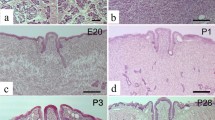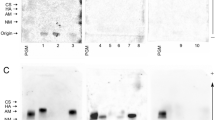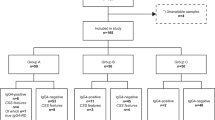Abstract
BIOLOGICAL work on salivary glands has revealed that sialic acid is the only acidic component in the bovine submaxillary gland and probably in the sublingual gland of the rat1–3. These findings resulted in the elaboration of a method for the removal of sialic acid in tissue sections known to contain abundant amounts of this sialo-mucin4,5. Such a method consisted of exposing the sections to acid hydrolysis at different pH's and temperatures.
This is a preview of subscription content, access via your institution
Access options
Subscribe to this journal
Receive 51 print issues and online access
$199.00 per year
only $3.90 per issue
Buy this article
- Purchase on Springer Link
- Instant access to full article PDF
Prices may be subject to local taxes which are calculated during checkout
Similar content being viewed by others
References
Blix, G., Z. physiol. Chem., 240, 43 (1936).
Nisizawa, K., and Pigman, W., Arch. Oral Biol., 1, 161 (1959).
Warren, L., and Spicer, S. S., Fed. Proc., 19, 147 (1960).
Quintarelli, G., Tsuiki, S., Hashimoto, Y., and Pigman, W., Biochem., Biophys. Res. Comm., 2, 423 (1960).
Quintarelli, G., Tsuiki, S., Hashimoto, Y., and Pigman, W., J. Histochem. and Cytochem. (in the press).
Pusztai, A., and Morgan, W. T. J., Nature, 182, 648 (1958).
Tasiro, K., Z. Immunitätsforsch., 93, 110 (1938).
Author information
Authors and Affiliations
Rights and permissions
About this article
Cite this article
QUINTARELLI, G., ROBINSON, L. Histochemistry of Human Sublingual Glands. Nature 189, 935–936 (1961). https://doi.org/10.1038/189935a0
Issue Date:
DOI: https://doi.org/10.1038/189935a0
This article is cited by
-
Zur Histochemie der Neuramins�ure
Histochemie (1969)
Comments
By submitting a comment you agree to abide by our Terms and Community Guidelines. If you find something abusive or that does not comply with our terms or guidelines please flag it as inappropriate.



